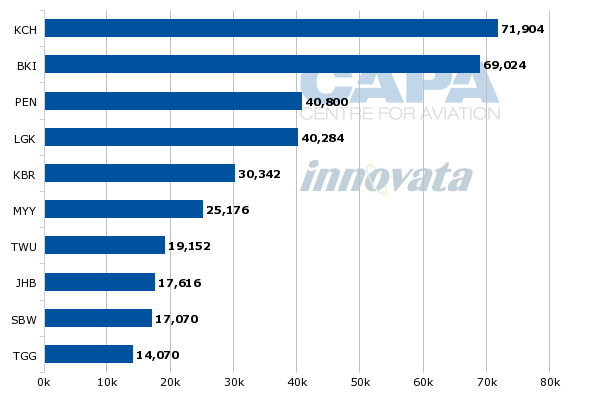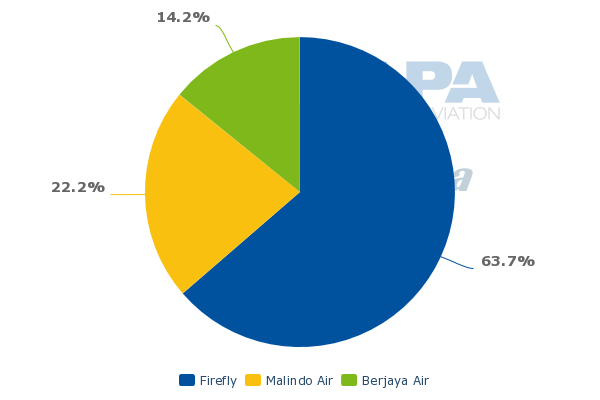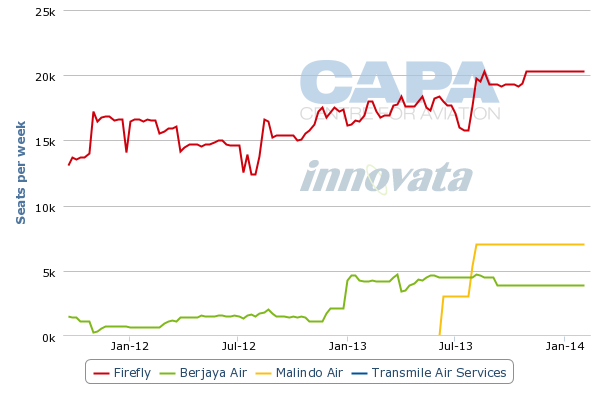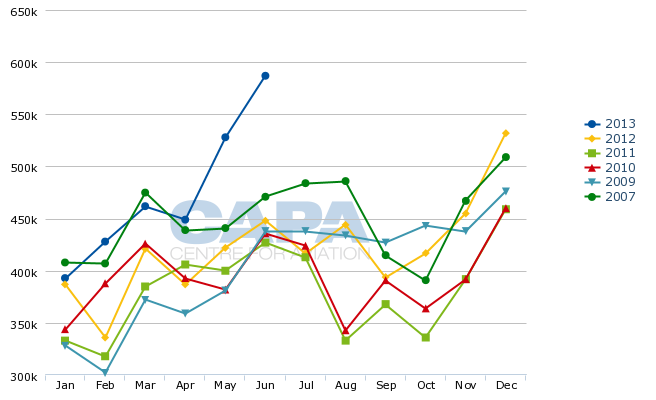Malindo Air launch drives 20% surge in Malaysia domestic traffic as MAS and AirAsia also expand
Malaysia's domestic market has seen a 20% surge in passenger traffic since the launch of Indonesia's Lion Group subsidiary Malindo Air.
Malindo Air began operations at the end of Mar-2013 and now operates 25 domestic flights across 11 routes, giving it about a 7% share of capacity in the Malaysian domestic market. Malaysia's other two main domestic carriers, AirAsia and Malaysia Airlines (MAS), have both responded by increasing capacity.
MAS has been expanding even faster than Malindo and been able to improve domestic load factors, albeit at the expense of yields. The flag carrier accounts for about 40% of the approximately 350,000 monthly passengers that have been added to Malaysia's domestic market while AirAsia and Malindo each account for about 30%.
The 20% to 25% domestic traffic increases that have been seen in Malaysia in recent months, making it one of the world's fastest growing domestic markets, are likely to continue for the remainder of 2013. But much more modest increases are expected over the medium to long term as Malindo and its two local competitors start to focus more on international expansion.
Malindo Air's first five months has focused on building up domestic network
Malindo launched services on 22-Mar-2013 on Malaysia's two biggest domestic routes, Kuala Lumpur International (KLIA) to Kota Kinabalu and Kuching with an initial fleet of two 737-900ERs in two-class configuration. Kuala Lumpur to Sibu, Miri and Tawau were added in Jun-2013 as Malindo expanded its 737-900ER fleet, which now consists of four aircraft.
See related report: Lion's Malindo breaks AirAsia-MAS duopoly in Malaysian domestic market
The carrier also opened a separate turboprop base on 1-Jun-2013 at Kuala Lumpur's near-city alternative airport, Subang. Malindo initially launched flights from Subang to Johor Bahru, Kota Bahru and Penang with one ATR 72-600. Another three Subang routes - to Alor Setar, Langkawi and Terengganu - were added on 1-Aug-2013. The carrier currently operates three ATR 72-600s.
Malindo competes on all five of its KLIA routes with both AirAsia and MAS. AirAsia and MAS both have at least twice as many frequencies on all five routes.
Frequency by carrier for KLIA to Kuching, Kota Kinabalu, Miri, Sibu and Tawau: 19-Aug-2013 to 25-Aug-2013
| Route | AirAsia | MAS | Malindo |
| KLIA-Kuching | 15/day | 11/day | 4/day |
| KLIA-Kota Kinabalu | 15/day | 11/day | 3/day |
| KLIA-Miri | 4/day | 5/day | 2/day |
| KLIA-Sibu | 5/day | 2/day | 1/day |
| KLIA-Tawau | 4/day | 2/day | 1/day |
KLIA sees surge in domestic traffic
Total domestic capacity from KLIA has increased year-over-year by 29% from about 322,000 to 416,000 weekly return seats, according to CAPA and Innovata data for the week commencing 19-Aug-2013 and 20-Aug-2012. Malindo has accounted for about 30% or 27,720 of these additional seats with its current KLIA schedule of 11 daily flights with 180-seat 737-900ERs.
AirAsia has expanded its domestic capacity from KLIA by 13% year-over-year to about 221,000 weekly return seats while MAS has expanded by a more aggressive 19% to about 150,000 weekly return seats.
Kuala Lumpur International Airport domestic capacity by carrier (one-way seats per week): 19-Sep-2011 to 9-Feb-2014
Malaysia Airports Holdings for 2Q2013, the first quarter of Malindo's operation, reported a 23.5% increase in domestic traffic to 3.6 million passengers. This includes a 26.2% increase in domestic traffic in Jun-2013. Malindo had seven scheduled daily flights at KLIA throughout Apr-2013 and May-2013 while in Jun-2013 it had between seven and 10 flights.
Kuala Lumpur International Airport passenger traffic: Jun-2013 vs Jun-2012 and 2Q2013 vs 2Q2012
KLIA's domestic traffic was up a more modest 7.3% to 10.6 million passengers in 1Q2013. This increase partly reflects capacity added by AirAsia and MAS in anticipation of Malindo's launch. As Malindo launched only nine days before the end of 1Q2013 its traffic during this period is negligible.
KLIA currently has 15 domestic routes, eight of which are located across the South China Sea in east Malaysia and seven of which are short hops within peninsular Malaysia. MAS serves all 15 of these routes while AirAsia serves 14, according to Innovata data.
Malindo will serve Langkawi and Penang from both Kuala Lumpur airports
Malindo's initial domestic strategy was to serve east Malaysian destinations from KLIA and peninsular Malaysia destinations from Subang. But the carrier has adjusted this strategy and decided to serve Langkawi and Penang from both Kuala Lumpur airports. Kuala Lumpur-Penang is slated to launch on 11-Sep-2013 with 11 weekly flights while Kuala Lumpur-Langkawi will launch the same day with seven weekly flights.
Penang and Langkawi are the third and fourth largest domestic destinations from KLIA after Kuching and Kota Kinabalu. Given the size of the Penang and Langkawi markets, it is logical for Malindo to match MAS in offering services to these destinations from both Kuala Lumpur airports.
Kuala Lumpur International Airport top 10 domestic destinations based on capacity (seats): 19-Aug-2013 to 25-Aug-2013
While Subang is attractive for point-to-point passengers as it is closer to central Kuala Lumpur than KLIA, Malindo needs to offer a KLIA option for domestic and soon international connections. Malindo in particular plans to offer a KLIA-Penang and Langkawi to its customers heading to and from India.
Penang has a large Indian population while Langkawi is a popular beach resort that Malindo will market to residents in the four Indian cities it plans to serve by the end of 2013 - Delhi, Mumbai, Kochi and Tiruchirappalli. Malindo is also planning to promote connections from India to the Indonesian resort island of Bali, which is one of four destinations in Indonesia the carrier also plans to launch by the end of 2013.
As reported on 15-Aug-2013 in the first article in this series of analysis reports on Malindo and the Malaysian market, Malindo is planning to focus mainly on international expansion in 2H2013 and 2014 as the carrier's CEO Chandran Rama Muthy sees more attractive opportunities in Malaysia's international market. He believes KLIA-Penang and KLIA-Langkawi will likely be the only new domestic jet routes for the remainder of this year but additional ATR 72s will enable more frequency on its six existing domestic markets from Subang as well as the opening of a second possible turboprop base at Kota Kinabalu.
See related report: Malindo emerges as Lion Group's main international carrier with nine new routes from Kuala Lumpur
Malindo drives a huge traffic increase at Subang Airport
Malindo already operates 14 daily flights from Subang, including four to Kota Bahru, three each to Johor Bahru and Penang, two to Terengganu and one each to Alor Setar and Langkawi. MAS regional subsidiary Firefly competes on all these routes, also with ATR 72s.
As in the case of Malindo's KLIA routes, MAS has at least twice as many frequencies as Malindo on all the Subang routes. This shows Malindo has an opportunity to grow further at Subang as it continues to expand its turboprop fleet. Firefly currently offers between 12 and 13 daily flights to Penang, 10 to Kota Bahru, between six and seven to Johor Bahru, six to Terengganu, between three and four to Alor Setar and three to Langkawi, according to Innovata data.
Firefly, which also serves a seventh domestic destination from Subang with 11 weekly flights to Kerteh, currently has a leading 64% share of seat capacity at the airport. Malindo has a 22% share of the Subang domestic market and small regional carrier Berjaya Air accounts for the remaining 14%. Berjaya Air operates domestic flights from Subang to Pangkor, Redang and Tioman - small islands off peninsular Malaysia where its sister company owns resorts - and also competes with Malindo and Firefly in the more mainstream Langkawi and Penang markets.
Kuala Lumpur Subang Airport capacity share (% of seats) by carrier: 19-Aug-2013 to 25-Aug-2013
Domestic seat capacity at Subang has increased by 72% year-over-year to about 64,000 return seats, according to CAPA and Innovata data. Malindo has accounted for just over half of the additional seats.
Firefly has responded by expanding at Subang by 19% year-over-year while Berjaya has more than doubled its capacity but on a very small base.
Kuala Lumpur Subang Airport domestic capacity by carrier (one-way seats per week): 19-Sep-2011 to 9-Feb-2014
Malaysia Airports plans to upgrade the current terminal at Subang to cope with the influx of new flights, including adding check-in counters and aircraft stands. Subang, which served as Kuala Lumpur's main airport before the opening of KLIA, is now only open to domestic and short-haul international turboprop flights. (Firefly serves neighbouring Indonesia, Singapore and Thailand while Berjaya Air only serves Thailand.)
Malindo hopes bus transfer can entice passengers to make some domestic to international connections
As AirAsia only operates from KLIA, it only competes indirectly with Malindo on Malindo's six Subang routes. The carrier does not plan service from both Kuala Lumpur airports to any destinations except for Langkawi and Penang. Malindo is instead working with Subang Airport to open up a bus connection to KLIA for passengers originating in its other peninsular Malaysia destinations and heading to east Malaysia or onto its planned international network.
A though check-in service is to be provided which management expects to be sufficient along with Malindo's good value fares to attract connecting passengers, despite the hassle of the airport transfer. Malindo, however, will likely find it difficult competing against AirAsia and MAS in markets such as Terengganu-Indonesia or Kota Bahru-India as its two competitors offer a wide range of same airport connections at Kuala Lumpur. Ultimately Malindo could be persuaded to launch more domestic destinations from KLIA to match its competitors.
While Malindo already has good coverage from KLIA to east Malaysia, with five of eight potential destinations, Penang and Langkawi will only give it two of the potential seven destinations in peninsular Malaysia. Of the remaining five, three are among the top 10 domestic routes from KLIA with at least 14,000 weekly seats - Kota Bahru, Johor Bahru and Terengganu.
Malindo looks at establishing new base at Kota Kinabalu
Malindo is also not interested at least for now in matching point-to-point domestic routes from Johor Bahru and Penang to east Malaysia. (AirAsia offers both and MAS operates from Johor Bahru to east Malaysia). But the carrier is studying potential domestic routes within east Malaysia - a market which is currently served by AirAsia, MAS and MAS regional subsidiary MASWings.
Malindo is now looking at placing its fourth ATR 72s, to be delivered in Oct-2013, in Kota Kinabalu. A turboprop base would allow Malindo to add new domestic markets such as Sandakan which would feed its flights from Kota Kinabalu to Kuala Lumpur and planned future international flights from Kota Kinabalu to China and Indonesia. Malindo is also looking at serving Tawau from Kota Kinabalu.
According to Innovata data, Malindo is dropping its Kuala Lumpur-Tawau route in mid to late Sep-2013. Malindo continues to list the Kuala Lumpur-Tawau route on its website but has stopped selling tickets between the two cities. Tawau and Sandakan are small markets which have limited non-stop services to Kuala Lumpur. Serving both destinations from Kota Kinabalu could be a more viable option for Malindo. In addition to offering connections, there is a large amount of local demand between Kota Kinabalu and Tawau and Sandakan as well as other domestic routes within east Malaysia.
AirAsia serves the Kota Kinabalu to Sandakan and Tawau routes with A320s while MAS uses a mix of 737-800s and ATR 72s in both markets. MASWings is the only carrier in several other short-haul domestic routes from Kota Kinabalu including Bintulu, Sibu and smaller subsidised routes to more rural destinations that Malindo would likely not be interested in serving. Mr Chandran says Malindo's potential Kota Kinabalu turboprop base would serve three to four destinations.
Malindo's domestic market share should reach 8%
The expansion of the domestic turboprop operation and slight expansion of the domestic jet operation should give Malindo about an 8% share of Malaysia's domestic market by the end of 2013. (Malindo is taking two more 737-900ERs in Sep-2013 but most of this additional capacity will be used for the international market.)
Malindo currently accounts for about a 7% share of capacity while market leader AirAsia accounts for 47% share and the MAS Group has a 45% share (includes 38% for MAS and MASWings, both of which operate under the MH code, and 7% for Firefly, which operates under its own FY code). Berjaya, the only Malaysian scheduled passenger carrier outside the AirAsia, MAS and Lion groups, accounts for less than 2% of the domestic market.
Malaysia domestic capacity share (% of seats) by carrier: 19-Aug-2013 to 25-Aug-2013
Total domestic capacity in the Malaysian market is currently up 25% over year ago levels. MAS has added about 34,000 weekly return seats, the equivalent of 17%, for a total of about 233,000 weekly return seats.
AirAsia has added about 36,000 seats but due to its bigger base it has expanded at a slightly slower clip than MAS, about 14% year-over-year, to 254,000 seats.
Malaysia total domestic capacity: 19-Aug-2013 to 25-Aug-2013
MAS records big gains in domestic traffic and load factor
MAS has seen its domestic traffic grow at an even faster clip as it has been able to improve its domestic load factor despite the intensifying competition.
In 2Q2013, MAS' domestic load factor improved by 2% from 72.1% to 74.1% as a 23.2% gain in RPKs outstripped a 19.8% gain in ASKs. Domestic passenger movements increased by 24.3% from 1.258 million in 2Q2012 to 1.563 million in 2Q2013.
In the month of June, the domestic gains at MAS were even more impressive despite Malindo having a much larger domestic operation in Jun-2013 compared to Apr/May-2013, when it had just two routes. MAS reported a 30.8% increase in domestic passenger traffic in Jun-2013 to 587,000 as its domestic load factor improved by 5.2pps to 83.7%.
MAS domestic operating highlights: Jun-2013 vs Jun-2012 and 1H2013 vs 1H2012
MAS domestic passenger levels are now at their highest level since 2007.
MAS domestic monthly passenger traffic: Jan-2007 to Jun-2013
The surge in the flag carrier's domestic traffic suggests the Malaysian market was ripe for stimulation. While AirAsia stimulated the market for several years following its 2001 launch, it had become a relatively comfortable duopoly. AirAsia in recent years has pursued more rapid expansion in Indonesia and Thailand while MAS restructured, leading to a drop in capacity levels. Malindo's entry has benefited consumers and the overall market as both MAS and AirAsia re-accelerated capacity expansion, compounding the impact made by the new entrant.
Malaysia's economy is also robust with growth of nearly 6% in 2012 and projected growth of about 5% in 2013. Demand for travel between east and peninsular Malaysia, where airlines do not compete with buses and trains as they do within peninsular Malaysia, has been particularly strong.
The sudden surge in growth, however, has inevitably come at the expense of yield. Malindo has come in with low promotional fares and a full-service product which includes meals, drinks, checked bags and seatback in-fight entertainment screens even in the 168-seat economy class cabin. MAS, which serves most domestic routes with 737-800s in a two-cabin configuration, has responding by reducing its fares. But the higher load factors have helped offset the decline in yield.
MAS reports small operating profit for 2Q2013
MAS has not yet provided any domestic/international breakdown or yield figures for 2Q2013 but the carrier did improve its bottom line during the quarter, suggesting the new competition may not be having a huge impact. MAS on 20-Aug-2013 reported an operating profit of MYR8 million (USD2 million) for 2Q2013 compared to an operating loss of MYR102 million (USD31 million) in 2Q2012, when it was still in restructuring mode.
MAS still incurred a net loss of MYR175 million (USD53 million) for 2Q2013, compared to a loss of MYR349 million (USD106 million) in 2Q2012, driven mainly by foreign currency losses and finance costs. Operating revenues increased 12% year-over-year to MYR3.594 billion (USD1.09 billion), driven by a 12% increase in passenger airline revenues to MYR3.145 billion (USD955 million). MAS has not yet provided a domestic/international revenue breakdown but for the full year in 2012 the domestic market accounted for 23% of the group's revenues.
"The Group remains focused on driving revenue through the introduction of new destinations and increased frequencies, aggressive marketing and promotions and better capacity management," MAS stated in its initial results announcement.
AirAsia load factors also remain high as profits increase
AirAsia also reported on 21-Aug-2013 an improvement in operating profits at its Malaysian subsidiary, an indication that it also has not been significantly impacted by the launch of a third competitor on domestic trunk routes. AirAsia (Malaysia) turned an operating profit of MYR244 million (USD74 million) in 3Q2013, a 19% increase compared to with 2Q2013.
But the carrier's net profit dropped 62% to MYR58 million (USD18 million) driven by foreign currency losses and higher taxes. Revenues were also up only 5% to MYR1.246 billion (379 million) as average fares dropped by 10% to MYR177 (USD54). This does show the potential impact of Malindo and the overall huge spike in domestic capacity on yield, although it is hard to pinpoint as AirAsia does not provide a domestic/international breakdown. Revenue per ASK was also down 6% to MYR15.75 cents (USD4.79 cents) - also likely dragged down by lower domestic yields although hard to quantify as only 44% of the carrier's ASKs are in the domestic market.
Unlike MAS, AirAsia did not provide a domestic/international breakdown in releasing its traffic figures for 2Q2013. But the system-wide load factor of its Malaysian subsidiary was flat in 2Q2013, at 80%, which indicates that the capacity it added in the market was sufficiently absorbed despite the intensifying competition. Again there has likely been some impact on yields although MAS from a fare perspective has responded much more aggressively than AirAsia.
AirAsia has previously stated it does not expect a significant impact from Malindo as it believes the new hybrid carrier competes more directly with MAS and Firefly, pointing to Malindo's two-class configuration, full-service product and turboprop operation at Subang. AirAsia has an all-A320 fleet in all-economy configuration and charges for baggage, food and drinks. Malindo's Mr Chandran sees the carrier filling "a niche between full service and low-cost".
Malindo also has been able to achieve average load factors of 75% to 80% in its first four months. Load factors on Kuching and Kota Kinabalu are "consistently above 80%". Kuching and Kota Kinabalu are Malindo's biggest and most mature routes as all of its other routes are less than three months old and hence are still in the development phase.
AirAsia (Malaysia) transported 5.5 million total passengers in 2Q2013, a 12% increase compared to 2Q2012. About 55% of the Malaysian carrier's seat capacity is currently allocated to the domestic market, according to CAPA and Innovata data.
Malaysian domestic market sees robust growth
All three of Malaysia's main carriers are fortunate the market has been able to grow with the additional capacity although at least some impact on yield would be expected. Malaysia's domestic market has grown by at least 350,000 monthly passengers - an impressive figure for a country of only about 30 million people that was already well served by Asia's largest LCC.
Jun-2013 figures from Malaysia Airports Holdings show not only a 273,000 or 26% year-over-year pick-up in domestic passengers at its flagship airport KLIA, but also a 429,000 or 22% year-over-year pick up in domestic passengers across its other 38 airports. For 2Q2013, there was a 692,000 or 24% passenger gain at KLIA and a 1,007,000 or 16% gain across the company's other airports.
As a result total domestic traffic at Malaysia Airports Holdings was up 702,000 in Jun-2013 and 1.7 million in 2Q2013. That puts the Malaysian domestic market up by over 350,000 passengers in recent months (half of 700,000 as the airport figures count each passenger twice) in Jun-2013, when Malindo was operating at slightly below current levels. (Malaysia Airports operates nearly every commercial airport in Malaysia. The only notable exception is Senai Airport at Johor Bahru, which has about 50,000 weekly seats.)
Malaysia Airports is confident the growth seen in recent months can be sustained as capacity levels remain at their new highs. Total growth in the Malaysian domestic market will likely end 2013 in the 16% to 18% range. After growth of only about 7% in 1Q2013, before Malindo launched, growth reached 20% in 2Q2013 and will likely exceed 20% in 2H2013.
With Malindo planning to start focusing more on international services, domestic growth rates in Malaysia will likely return to more normal levels in 2014. While the sudden domestic capacity spike seen in recent months seems alarming, the capacity has been quickly absorbed and over time yields should recover. If so, that will mean that the Malaysian market has successfully absorbed the operation of three fierce competitors - an impressive feat, given that just a decade ago many of the domestic routes involved were government subsidised monopolies.









